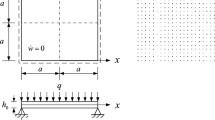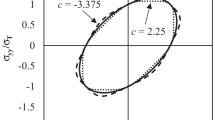Abstract
Large-deformation pure cylindrical bending of a homogeneous strip of uniform finite thickness with micropolar (Cosserats’) material constitution is analysed and related both to the large-deformation solution of classical (Cauchy’s) continuum theory and that of the small-deformation (linear) micropolar theory, known to exhibit a size effect. For a micropolar generalisation of the semi-linear material, the closed-form solution is obtained using a semi-inverse approach, which is equivalent to the solution in classical elasticity, possessing the same relationship between the curvature and the distribution of stress components and exhibiting the same softening effect relative to the linear solution. A couple stress of constant amount over the cross section develops in addition, in proportion to the curvature and the squared ratio between the characteristic bending length of the material and the thickness of the specimen and linear in Poisson’s ratio, in the same way as in the linear micropolar elasticity. The compound effect of non-linear softening and micropolar stiffening is analysed in detail with the view of providing a theoretical background for development of architected materials with internal structure for large-displacement applications. In particular, the size-effect estimate supplied by the linear analysis is shown to be in error, which builds up rapidly in highly deformed materials with relatively large characteristic bending length.













Similar content being viewed by others
References
Berglund, K.: Generalization of Saint-Venant’s principle to micropolar continua. Arch. Ration. Mech. Anal. 64, 317–326 (1977)
Blatz, P.J., Ko, W.L.: Application of finite elasticity to the deformation of rubbery materials. Trans. Soc. Rheol. 6, 223–251 (1962)
Bruhns, O.T., Xiao, H., Meyers, A.: Finite bending of a rectangular block of an elastic Hencky material. J. Elast. 66, 237–256 (2002)
Carroll, M.M., Horgan, O.: Finite strain solutions for compressible elastic solid. Q. Appl. Math. 48, 767–780 (1990)
Cosserat, F., Cosserat, E.: Théorie des corps déformables, A. Hermann et Fils, Paris, (1909)
Gauthier, R., Jahsman, W.E.: A Quest for Micropolar Elastic Constants. J. Appl. Mech. 42(2), 369–374 (1975)
Grbčić, S., Jelenić, G., Ribarić, D.: Quadrilateral 2D linked-interpolation finite elements for micropolar continuum. Acta. Mech. Sin. 35, 1001–1020 (2019)
Grbčić, S., Jelenić, G., Ibrahimbegović, A.: Geometrically non-linear 3D finite-element analysis of micropolar continuum. Int. J. Solids Struct. 202, 745–764 (2020)
Hill, R.: On constitutive inequalities for simple materials - I. J. Mech. Phys. Solids 16(4), 229–242 (1968)
Ieşan, D.: On Saint-Venant’s problem in micropolar elasticity. Int. J. Eng. Sci. 9, 879–888 (1971)
Jelenić, G.: Pure bending in non-linear elasticity: closed-form 2D solution for semi-linear orthotropic material. Eur. J. Mech. A/Solids 90, 104289 (2021)
John, F.: Plane strain problems for a perfectly elastic material of harmonic type. Commun. Pure Appl. Math. 13, 239–296 (1960)
Kafadar, C.B., Eringen, A.C.: Micropolar media - I. The classical theory. Int. J. Eng. Sci. 9, 271–305 (1971)
Karyakin, M., Kalashnikov, V., Shubchinskaya, N.: Nonlinear effects in a plane problem of the pure bending of an elastic rectangular panel. Int. J. Eng. Sci. 80, 90–105 (2014)
Kassianidis, F., Ogden, R.W.: On large bending deformations of transversely isotropic rectangular elastic blocks. Note di Matematica 27, 131–154 (2007)
Lakes, R.S.: Physical Meaning of Elastic Constants in Cosserat, Void, and Microstretch Elasticity. Mech. Mater. Struct. 11(3), 1–13 (2016)
Lurie, A.: Nonlinear Theory of Elasticity. North-Holland, Amsterdam (1990)
Nakamura, S., Lakes, R.S.: Finite element analysis of Saint-Venant end effects in micropolar elastic solids. Eng. Comput. 12, 571–587 (1995)
Ogden, R.W.: Non-Linear Elastic Deformations. Dover Publications Inc, Mineola, New York (1984)
Oldfather, W.A., Ellis, C.A., Brown, D.M.: Leonhard Euler’s elastic curves. Isis 20(1), 72–160 (1933)
Pham, M.-S., Liu, C., Todd, I., Lertthanasarn, J.: Damage-tolerant architected materials inspired by crystal microstructure. Nature 565, 305–311 (2019)
Pietraszkiewicz, W., Eremeyev, V.A.: On natural strain measures of the non-linear micropolar continuum. Int. J. Solids Struct. 46(3–4), 774–787 (2009)
Rivlin, R.S.: Large elastic deformations of isotropic materials. V. The problem of flexture. Proc. R. Soc. A 195, 463–473 (1949)
Seth, B.: Generalized strain measure with respect to applications to physical problems, Tech. rep., University of Wisconsin, Mathematics Research Center, Technical Summary Report No. 248, Madison, Wisconsin (1961)
Seth, B.R.: Finite strain in elastic problems. Philosop. Trans. R. Soc. Lond. A 234, 231–264 (1935)
Timoshenko, S., Goodier, J.: Theory of Elasticity. McGraw-Hill, New York (1951)
Toupin, R.A.: Saint-Venant’s principle. Arch. Ration. Mech. Anal. 18, 83–96 (1965)
Xia, X., Afshar, A., Yang, H., Portela, C.M., Kochmann, D.M., Di Leo, C.V., Greer, J.R.: Electrochemically reconfigurable architected materials. Nature 573, 205–213 (2019)
Acknowledgements
The presented research has been financially supported by the Croatian Science Foundation project Fixed-pole Concept in Numerical Modelling of Cosserats’ Continuum (HRZZ-IP-2018-01-1732), and the University of Rijeka grant Computational and Experimental Procedures for Assessment of Material Parameters in Cosserats’ Continuum (uniri-tehnic-18-248 1415).
Author information
Authors and Affiliations
Corresponding author
Additional information
Publisher's Note
Springer Nature remains neutral with regard to jurisdictional claims in published maps and institutional affiliations.
Appendix: Solution in small-deformation regime
Appendix: Solution in small-deformation regime
Since \(\zeta = \frac{h}{2} \frac{m_0}{\omega }\) and \(\zeta = \frac{1}{2} \ln \frac{1+{\bar{p}}_0}{1-{\bar{p}}_0} = {\bar{p}}_0 + \frac{1}{3} {\bar{p}}_0^3 + \frac{1}{5} {\bar{p}}_0^5 + \mathcal{O} \left( {\bar{p}}_0^7 \right)\), in the linear case there follows \(\zeta = {\bar{p}}_0\) and \(\frac{m_0}{p_0} = \frac{2\omega }{{\tilde{E}}h}\). Next, the coefficient \(\kappa = 6 \frac{\sinh 2 \zeta - 2 \zeta }{(2\zeta )^2\sinh 2 \zeta } \frac{\tanh \zeta }{\zeta }\) in (19) may be expanded as \(\kappa = 6 \frac{2 \zeta + \frac{(2\zeta )^3}{6} + \frac{(2\zeta )^5}{120} + \mathcal{O} (\zeta ^7) - 2 \zeta }{(2\zeta )^2 \left[ 2 \zeta + \frac{(2\zeta )^3}{6} + \frac{(2\zeta )^5}{120} + \mathcal{O} (\zeta ^7) \right] } \frac{\zeta - \frac{\zeta ^3}{3} + \mathcal{O} (\zeta ^5)}{\zeta } = 1 - \frac{4\zeta ^2}{5} + \mathcal{O} (\zeta ^4)\), and thus \(\lim _{\zeta \rightarrow 0} M = p_0 W \left( 1 + \frac{12\omega }{{\tilde{E}} h^2} \right) = m_0 A \left( 1+ \frac{{\tilde{E}} h^2}{12 \omega } \right)\). Conversely,
with \(\phi = 24 (1-n) \left( \frac{l_b}{h} \right) ^2\) introduced in (20). For \(\zeta \rightarrow 0\), \(\cosh \eta = 1\), \(\sinh \eta = \frac{2 \zeta X^2}{h}\) and \(e^{-\eta } = 1 - \frac{2 \zeta X^2}{h}\), thus the strain and stress components in (22) turn into
Turning to the deformed geometry, since \(\cosh \eta = 1 + \frac{\eta ^2}{2} + \mathcal{O} \left( \zeta ^4 \right)\), \(\sinh \eta = \eta + \mathcal{O} \left( \zeta ^3 \right)\) and \(\cosh \zeta = 1 + \frac{\zeta ^2}{2} + \mathcal{O} \left( \zeta ^4 \right)\), from radial position (13) we obtain \(\frac{r}{\rho }= 1 + a - \frac{\eta + \mathcal{O} \left( \zeta ^3 \right) + a \left[ 1 + \frac{\eta ^2}{2} + \mathcal{O} \left( \zeta ^4 \right) \right] }{1 + \frac{\zeta ^2}{2} + \mathcal{O} \left( \zeta ^4 \right) } = 1 - \eta + \frac{a}{2} \left( \zeta ^2 - \eta ^2 \right) + \mathcal{O} \left( \zeta ^3 \right)\), while of course, \(\theta = \frac{2\zeta }{h} X^1\). In addition, \(\cos \xi = 1 - \frac{\xi ^2}{2} + \mathcal{O} \left( \zeta ^4 \right)\) and \(\sin \xi = \xi + \mathcal{O} \left( \zeta ^3 \right)\), thus from (15), \(X^1 = \rho \xi\) and \(\eta = \frac{2 X^2}{h} \zeta\) we have
Using (3), for \(\zeta ^2 \rightarrow 0\) the displacements \(u^1 = x^1 - x^1_0\) and \(u^2 = x^2 - x^2_0\) become
since \(X^2_e = \frac{h}{4} a \zeta + \mathcal{O} \left( \zeta ^2 \right)\). The last result follows from \(r(X^2_e)=\rho\), i.e. as a solution of the quadratic equation \(\left( \frac{2 \zeta X^2_e}{h} \right) ^2 + \frac{2}{a} \frac{2 \zeta X^2_e}{h} - \zeta ^2 = \mathcal{O} \left( \zeta ^3 \right)\) coming out of (13), which in this case gives \(a \left( \cosh \zeta - \cosh \eta _e \right) = \sinh \eta _e\). Substitutions \(\cosh \eta _e = 1 + \frac{1}{2} \eta _e^2 + \mathcal{O} \left( \zeta ^4 \right)\), \(\sinh \eta _e = \eta _e + \mathcal{O} \left( \zeta ^3 \right)\) and \(\eta _e = \frac{2 X^2_e}{h} \zeta\) are used in the derivation.
Finally, making use of (A.1), the displacement components and the rotation of a material point X are obtained as
which correspond to the known linear results derived in Gauthier and Jahsman (1975), Grbčić et al. (2019). For \(\phi =0\), these results, as well as those in (A.2), reduce to the classical solution (Timoshenko and Goodier 1951).
Rights and permissions
About this article
Cite this article
Jelenić, G. Pure bending in non-linear micropolar elasticity. Int J Mech Mater Des 18, 243–265 (2022). https://doi.org/10.1007/s10999-021-09577-3
Received:
Accepted:
Published:
Issue Date:
DOI: https://doi.org/10.1007/s10999-021-09577-3




